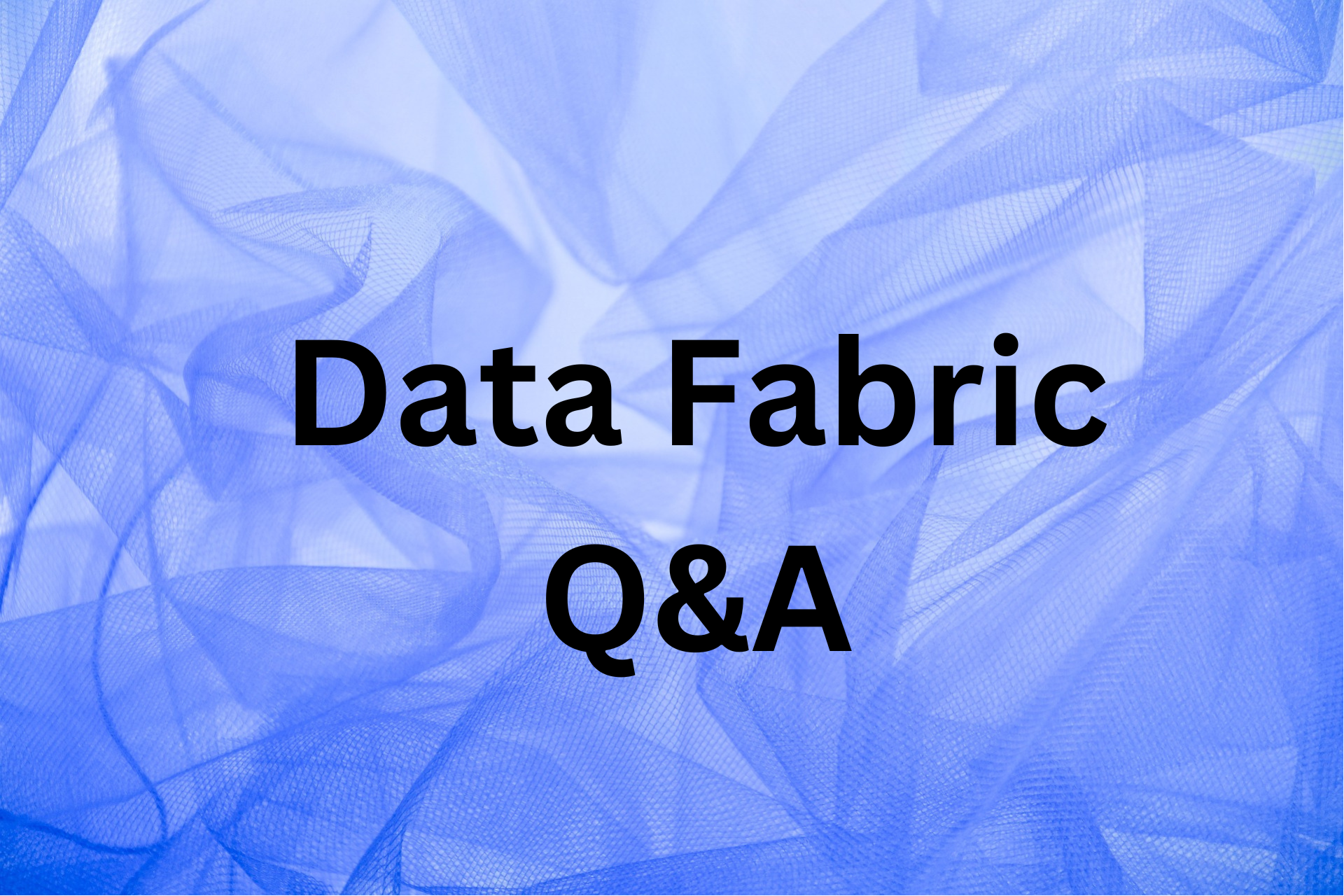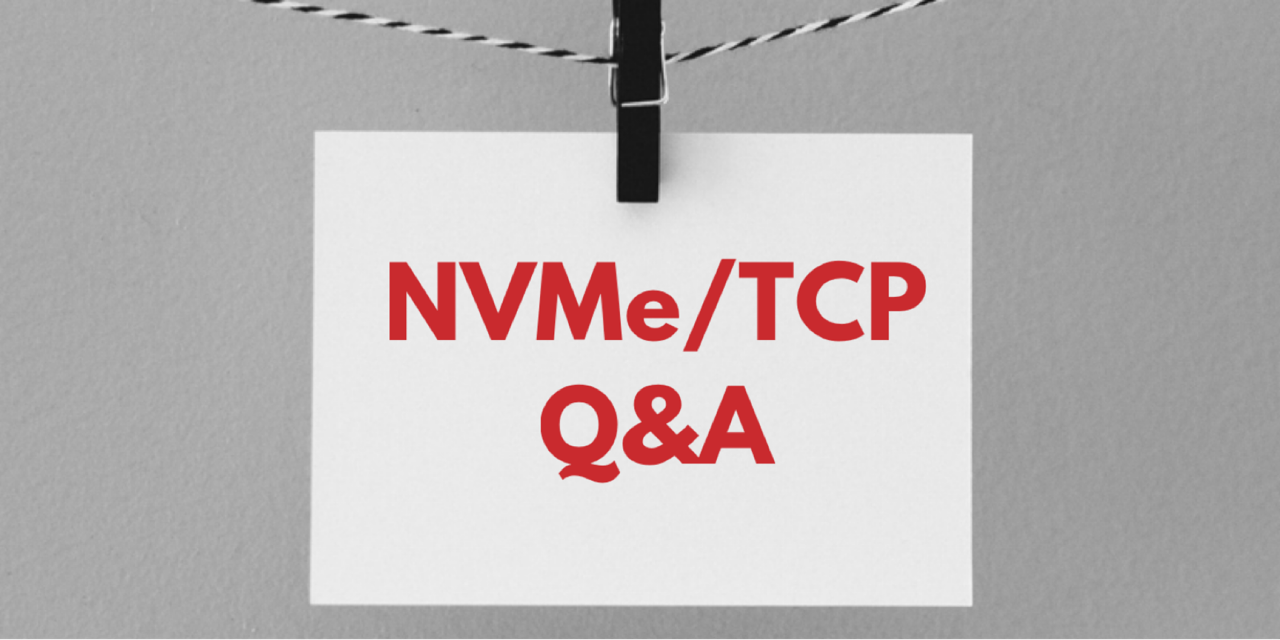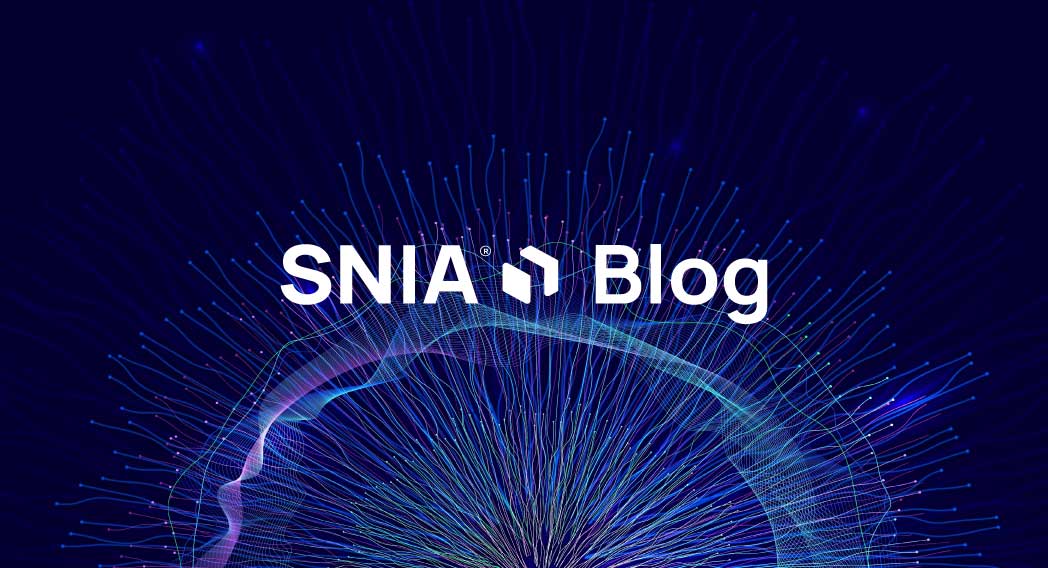
Data Fabric Q&A
Aug 21, 2023

NVMe®/TCP Q&A
Aug 7, 2023

- SLES 15 SP4 and SP5 - Inbox
- RHEL 9.X - Inbox (Tech Preview) [RHEL 8.X: not available]
- Ubuntu 22.04 - Universe (Community support)
Leave a Reply
NVMe®/TCP Q&A
Aug 7, 2023

- SLES 15 SP4 and SP5 – Inbox
- RHEL 9.X – Inbox (Tech Preview) [RHEL 8.X: not available]
- Ubuntu 22.04 – Universe (Community support)
Leave a Reply
Open Standards Featured at FMS 2023
Jul 31, 2023

SNIA welcomes colleagues to join them at the upcoming Flash Memory Summit, August 8-10, 2023 in Santa Clara CA. SNIA is pleased to join standards organizations CXL Consortium (CXL
(CXL ), PCI-SIG®, and Universal Chiplet Interconnect Express
), PCI-SIG®, and Universal Chiplet Interconnect Express (UCIe
(UCIe ) in an Open Standards Pavilion, Booth #725, in the Exhibit Hall. CMSI will feature SNIA member companies in a computational storage cross industry demo by Intel, MINIO, and Solidigm and a Data Filtering demo by ScaleFlux; a software memory tiering demo by VMware; a persistent memory workshop and hackathon; and the latest on SSD form factors E1 and E3 work by SNIA SFF TA Technical work group. SMI will showcase SNIA Swordfish® management of NVMe SSDs on Linux with demos by Intel Samsung and Solidigm. CXL will discuss their advances in coherent connectivity. PCI-SIG will feature their PCIe 5.0 architecture (32GT/s) and PCIe 6.0 (65GT/s) architectures and industry adoption and the upcoming PCIe 7.0 specification development (128GT/s). UCIe will discuss their new open industry standard establishing a universal interconnect at the package-level. SNIA STA Forum will also be in Booth #849 – learn more about the SCSI Trade Association joining SNIA. These demonstrations and discussions will augment FMS program sessions in the SNIA-sponsored System Architecture Track on memory, computational storage, CXL, and UCIe standards. A SNIA mainstage session on Wednesday August 9 at 2:10 pm will discuss Trends in Storage and Data: New Directions for Industry Standards. SNIA colleagues and friends can receive a $100 discount off the 1-, 2-, or 3-day full conference registration by using code SNIA23. Visit snia.org/fms to learn more about the exciting activities at FMS 2023 and join us there! The post Open Standards Featured at FMS 2023 first appeared on SNIA Compute, Memory and Storage Blog.
) in an Open Standards Pavilion, Booth #725, in the Exhibit Hall. CMSI will feature SNIA member companies in a computational storage cross industry demo by Intel, MINIO, and Solidigm and a Data Filtering demo by ScaleFlux; a software memory tiering demo by VMware; a persistent memory workshop and hackathon; and the latest on SSD form factors E1 and E3 work by SNIA SFF TA Technical work group. SMI will showcase SNIA Swordfish® management of NVMe SSDs on Linux with demos by Intel Samsung and Solidigm. CXL will discuss their advances in coherent connectivity. PCI-SIG will feature their PCIe 5.0 architecture (32GT/s) and PCIe 6.0 (65GT/s) architectures and industry adoption and the upcoming PCIe 7.0 specification development (128GT/s). UCIe will discuss their new open industry standard establishing a universal interconnect at the package-level. SNIA STA Forum will also be in Booth #849 – learn more about the SCSI Trade Association joining SNIA. These demonstrations and discussions will augment FMS program sessions in the SNIA-sponsored System Architecture Track on memory, computational storage, CXL, and UCIe standards. A SNIA mainstage session on Wednesday August 9 at 2:10 pm will discuss Trends in Storage and Data: New Directions for Industry Standards. SNIA colleagues and friends can receive a $100 discount off the 1-, 2-, or 3-day full conference registration by using code SNIA23. Visit snia.org/fms to learn more about the exciting activities at FMS 2023 and join us there! The post Open Standards Featured at FMS 2023 first appeared on SNIA Compute, Memory and Storage Blog.
Leave a Reply
So Just What Is An SSD?
Jul 19, 2023

Leave a Reply
Your Questions Answered on Persistent Memory, CXL, and Memory Tiering
Jul 10, 2023

 and applications like memory tiering, our recent Persistent Memory, CXL, and Memory Tiering-Past, Present, and Future webinar was a big success. If you missed it, watch it on demand HERE!
Many questions were answered live during the webinar, but we did not get to all of them. Our moderator Jim Handy from Objective Analysis, and experts Andy Rudoff and Bhushan Chithur from Intel, David McIntyre from Samsung, and Sudhir Balasubramanian and Arvind Jagannath from VMware have taken the time to answer them in this blog. Happy reading!
Q: What features or support is required from a CXL capable endpoint to e.g. an accelerator to support the memory pooling? Any references?
A: You will have two interfaces, one for the primary memory accesses and one for the management of the pooling device. The primary memory interface is the .mem and the management interface will be via the .io or via a sideband interface. In addition you will need to implement a robust failure recovery mechanism since the blast radius is much larger with memory pooling.
Q: How do you recognize weak information security (in CXL)?
A: CXL has multiple features around security and there is considerable activity around this in the Consortium. For specifics, please see the CXL Specification or send us a more specific question.
Q: If the system (e.g. x86 host) wants to deploy CXL memory (Type 3) now, is there any OS kernel configuration, BIO configuration to make the hardware run with VMWare (ESXi)? How easy or difficult this setup process?
A: A simple CXL Type 3 Memory Device providing volatile memory is typically configured by the pre-boot environment and reported to the OS along with any other main memory. In this way, a platform that supports CXL Type 3 Memory can use it without any additional setup and can run an OS that contains no CXL support and the memory will appear as memory belonging to another NUMA code. That said, using an OS that does support CXL enables more complex management, error handling, and more complex CXL devices.
Q: There was a question on ‘Hop” length. Would you clarify?
A: In the webinar around minute 48, it was stated that a Hop was 20ns, but this is not correct. A Hop is often spoken of as “Around 100ns.” The Microsoft Azure Pond paper quantifies it four different ways, which range from 85ns to 280ns.
Q: Do we have any idea how much longer the latency will be?
A: The language CXL folks use is “Hops.” An address going into CXL is one Hop, and data coming back is another. In a fabric it would be twice that, or four Hops. The latency for a Hop is somewhere around 100ns, although other latencies are accepted.
Q: For memory semantic SSD: There appears to be a trend among 2LM device vendors to presume the host system will be capable of providing telemetry data for a device-side tiering mechanism to decide what data should be promoted and demoted. Meanwhile, software vendors seem to be focused on the devices providing telemetry for a host-side tiering mechanism to tell the device where to move the memory. What is your opinion on how and where tiering should be enforced for 2LM devices like a memory semantic SSD?
A: Tiering can be managed both by the host and within computational storage drives that could have an integrated compute function to manage local tiering- think edge applications.
Q: Re VM performance in Tiering: It appears you’re comparing the performance of 2 VM’s against 1. It looked like the performance of each individual VM on the tiering system was slower than the DRAM only VM. Can you explain why we should take the performance of 2 VMs against the 1 VM? Is the proposal that we otherwise would have required those 2 VM’s to run on separate NUMA node, and now they’re running on the same NUMA node?
A: Here the use case was, lower TCO & increased capacity of memory along with aggregate performance of VM’s v/s running few VM’s on DRAM. In this use case, the DRAM per NUMA Node was 384GB, the Tier2 memory per NUMA node was 768GB. The VM RAM was 256GB.
In the DRAM only case, if we have to run business critical workloads e.g., Oracle with VM RAM=256GB, we could only run 1 VM (256GB) per NUMA Node (DRAM=384GB), we cannot over-provision memory in the DRAM only case as every NUMA node has 384GB only. So potentially we could run 4 such VM’s (VM RAM=256Gb) in this case with NUMA node affinity set as we did in this use case OR if we don’t do NUMA node affinity, maybe 5 such VM’s without completely maxing out the server RAM. Remember, we did NUMA node affinity in this use case to eliminate any cross NUMA latency.78
Now with Tier2 memory in the mix, each NUMA node has 384GB DRAM and 768GB Tier2 Memory, so theoretically one could run 16-17 such VM’s (VM RAM =256GB), hence we are able to increase resource maximization, run more workloads, increase transactions etc , so lower TCO, increased capacity and aggregate performance improvement.
Q: CXL is changing very fast, we have 3 protocol versions in 2 years, as a new consumer of CXL what are the top 3 advantages of adopting CXL right away v/s waiting for couple of more years?
A: All versions of CXL are backward compatible. Users should have no problem using today’s CXL devices with newer versions of CXL, although they won’t be able to take advantage of any new features that are introduced after the hardware is deployed.
Q: (What is the) ideal when using agilex FPGAs as accelerators?
A: CXL 3.0 supports multiple accelerators via the CXL switching fabric. This is good for memory sharing across heterogeneous compute accelerators, including FPGAs.
Thanks again for your support of SNIA education, and we invite you to write askcmsi@snia.org for your ideas for future webinars and blogs!
The post Your Questions Answered on Persistent Memory, CXL, and Memory Tiering first appeared on SNIA Compute, Memory and Storage Blog.
and applications like memory tiering, our recent Persistent Memory, CXL, and Memory Tiering-Past, Present, and Future webinar was a big success. If you missed it, watch it on demand HERE!
Many questions were answered live during the webinar, but we did not get to all of them. Our moderator Jim Handy from Objective Analysis, and experts Andy Rudoff and Bhushan Chithur from Intel, David McIntyre from Samsung, and Sudhir Balasubramanian and Arvind Jagannath from VMware have taken the time to answer them in this blog. Happy reading!
Q: What features or support is required from a CXL capable endpoint to e.g. an accelerator to support the memory pooling? Any references?
A: You will have two interfaces, one for the primary memory accesses and one for the management of the pooling device. The primary memory interface is the .mem and the management interface will be via the .io or via a sideband interface. In addition you will need to implement a robust failure recovery mechanism since the blast radius is much larger with memory pooling.
Q: How do you recognize weak information security (in CXL)?
A: CXL has multiple features around security and there is considerable activity around this in the Consortium. For specifics, please see the CXL Specification or send us a more specific question.
Q: If the system (e.g. x86 host) wants to deploy CXL memory (Type 3) now, is there any OS kernel configuration, BIO configuration to make the hardware run with VMWare (ESXi)? How easy or difficult this setup process?
A: A simple CXL Type 3 Memory Device providing volatile memory is typically configured by the pre-boot environment and reported to the OS along with any other main memory. In this way, a platform that supports CXL Type 3 Memory can use it without any additional setup and can run an OS that contains no CXL support and the memory will appear as memory belonging to another NUMA code. That said, using an OS that does support CXL enables more complex management, error handling, and more complex CXL devices.
Q: There was a question on ‘Hop” length. Would you clarify?
A: In the webinar around minute 48, it was stated that a Hop was 20ns, but this is not correct. A Hop is often spoken of as “Around 100ns.” The Microsoft Azure Pond paper quantifies it four different ways, which range from 85ns to 280ns.
Q: Do we have any idea how much longer the latency will be?
A: The language CXL folks use is “Hops.” An address going into CXL is one Hop, and data coming back is another. In a fabric it would be twice that, or four Hops. The latency for a Hop is somewhere around 100ns, although other latencies are accepted.
Q: For memory semantic SSD: There appears to be a trend among 2LM device vendors to presume the host system will be capable of providing telemetry data for a device-side tiering mechanism to decide what data should be promoted and demoted. Meanwhile, software vendors seem to be focused on the devices providing telemetry for a host-side tiering mechanism to tell the device where to move the memory. What is your opinion on how and where tiering should be enforced for 2LM devices like a memory semantic SSD?
A: Tiering can be managed both by the host and within computational storage drives that could have an integrated compute function to manage local tiering- think edge applications.
Q: Re VM performance in Tiering: It appears you’re comparing the performance of 2 VM’s against 1. It looked like the performance of each individual VM on the tiering system was slower than the DRAM only VM. Can you explain why we should take the performance of 2 VMs against the 1 VM? Is the proposal that we otherwise would have required those 2 VM’s to run on separate NUMA node, and now they’re running on the same NUMA node?
A: Here the use case was, lower TCO & increased capacity of memory along with aggregate performance of VM’s v/s running few VM’s on DRAM. In this use case, the DRAM per NUMA Node was 384GB, the Tier2 memory per NUMA node was 768GB. The VM RAM was 256GB.
In the DRAM only case, if we have to run business critical workloads e.g., Oracle with VM RAM=256GB, we could only run 1 VM (256GB) per NUMA Node (DRAM=384GB), we cannot over-provision memory in the DRAM only case as every NUMA node has 384GB only. So potentially we could run 4 such VM’s (VM RAM=256Gb) in this case with NUMA node affinity set as we did in this use case OR if we don’t do NUMA node affinity, maybe 5 such VM’s without completely maxing out the server RAM. Remember, we did NUMA node affinity in this use case to eliminate any cross NUMA latency.78
Now with Tier2 memory in the mix, each NUMA node has 384GB DRAM and 768GB Tier2 Memory, so theoretically one could run 16-17 such VM’s (VM RAM =256GB), hence we are able to increase resource maximization, run more workloads, increase transactions etc , so lower TCO, increased capacity and aggregate performance improvement.
Q: CXL is changing very fast, we have 3 protocol versions in 2 years, as a new consumer of CXL what are the top 3 advantages of adopting CXL right away v/s waiting for couple of more years?
A: All versions of CXL are backward compatible. Users should have no problem using today’s CXL devices with newer versions of CXL, although they won’t be able to take advantage of any new features that are introduced after the hardware is deployed.
Q: (What is the) ideal when using agilex FPGAs as accelerators?
A: CXL 3.0 supports multiple accelerators via the CXL switching fabric. This is good for memory sharing across heterogeneous compute accelerators, including FPGAs.
Thanks again for your support of SNIA education, and we invite you to write askcmsi@snia.org for your ideas for future webinars and blogs!
The post Your Questions Answered on Persistent Memory, CXL, and Memory Tiering first appeared on SNIA Compute, Memory and Storage Blog.
Leave a Reply
Considerations and Options for NVMe/TCP Deployment
Jun 16, 2023

- How does NVMe/TCP stack up against my existing block storage protocol of choice in terms of performance?
- Should I use a dedicated storage network when deploying NVMe/TCP or is a converged network ok?
- How can I automate interaction with my IP-Based SAN?
Leave a Reply
Considerations and Options for NVMe/TCP Deployment
Jun 16, 2023

- How does NVMe/TCP stack up against my existing block storage protocol of choice in terms of performance?
- Should I use a dedicated storage network when deploying NVMe/TCP or is a converged network ok?
- How can I automate interaction with my IP-Based SAN?
Leave a Reply
Connector and Cable differences: SAS-3 vs. SAS-4
Jun 14, 2023

By: David Einhorn, SCSI Trade Association Board of Directors; Business Development Manager, North America, Amphenol Corp., June 14, 2022
This blog post examines the differences between SAS-3 and SAS-4 connectors and cables. With the new generation of SAS, we see multiple upgrades and improvements.
Drive connector
[Note: 24G SAS uses the SAS-4 physical layer, which operates at a baud rate of 22.5Gb/s.]
The 29-position receptacle and plug connectors used in SAS-4 feature: hot-plugging, blind-mating, connector misalignment correction, and a PCB retention mechanism for robust SMT attachment. The connectors are SATA compliant and available across many suppliers in range of vertical and right-angle configurations. Typical applications are consistent with previous generations of server and storage equipment, HDDs, HDD carriers, and SSDs.
To fulfill the needs of next-generation servers, several improvements have been implemented. Raw materials have been upgraded, housing designs and terminal geometries have been modified to meet signal integrity requirements at 24G SAS speeds while maintaining the footprint of existing SAS-3 for easy upgrades.
- Compliant to SFF8681 specification
- Footprint backward compatible to 3Gb/s, 6Gb/s, and 12G SAS connectors
- Staggered contact lengths for hot plugging applications
- Receptacles are available in SMT, through-hole and hybrid PCB attach methods
- Header is available in right angle and vertical orientation
- Supports both SAS and SATA drives
Ultimately, the goal was to design a connector with the mechanical and electrical reliability which has been part of every previous SAS generation and improve the signal integrity to meet the 24G SAS need while maintaining backward compatibility.
Drive cable assembly
SAS-4 cables for next-generation servers perform to 24G SAS speeds with a significant size and density improvement from previous generations. An 8x SlimSAS consumes the same area as a 4x MiniSAS HD. From a construction standpoint, SlimSAS series plug connectors include an anti-skew feature for misalignment correction. An optimized raw cable structure and upgraded cable manufacturing process enables the enhanced signal integrity performance requirements of SAS-4. Additionally, the plug connector internal components have been optimized to control and stabilize the impedance. The connectors are compliant with SFF-8654 and meet a wide range of straight, right-angle, left-side and right-side exit configurations to solve most mechanical/dimensional constraints.
- Compliant to SFF-8654 specification
- Supports various plug connector types: straight, right angle, left-side exit, and right-side exit
- Anti-skew feature is optional for special applications
- Pull-tab is available for all type connectors
- Anti-reverse right angle plug connector is available for supporting special applications
- Metal latch adds robustness and improves on previous generations (MiniSAS HD)
- Supports SAS, PCIe, UPI1.0, NVM Express® and NVLink® 25G applications
- Supports 4x, 6x, 8x, and 12x configurations
The industry set out to design a high-performance cable assembly with the mechanical and electrical reliability which improves upon every previous SAS generation and improves the signal integrity to meet the SAS-4 requirements. The standards based SlimSAS product lines have been proven to reliably meet or exceed the storage industry needs.
Find a similar article by tags
UncategorizedLeave a Reply
Training Deep Learning Models Q&A
May 19, 2023








Leave a Reply